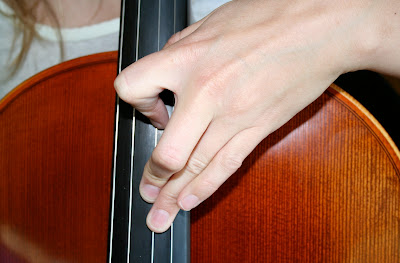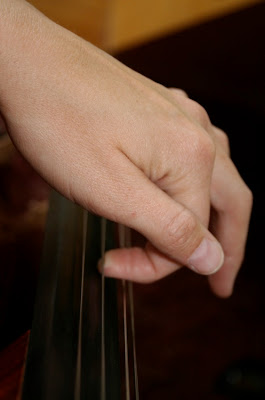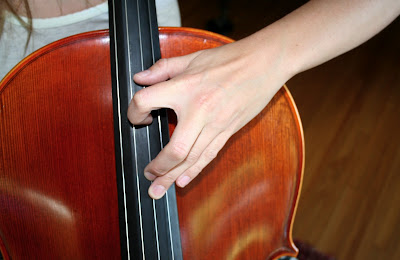I wrote this post about 2.5 years ago, and I thought that I might keep this blog perhaps a little cello-y while I finish writing my papers and whip up the Cellomas video by reposting it. The cello blogosphere has changed so much since I started writing in 2007: many of the people who were established fixtures of blogspot and wordpress are now barely posting, while newer writers remind us fogeys of what it was like to have enough vim and vigor to write every day.
While I am going to immerse myself in cognitive neuroscience literature reviews and my new love of curriculum writing for the next few days, I welcome questions and suggestions. The end of December and most of January are fairly free.
Enjoy.
_______________
Hahaa! I bet you didn’t expect a technical post today! Well, I enjoy the element of surprise now and again.
One of my newer readers, Eigen voiced a pretty common question about left hand technique: What is up with 1st finger in thumb position? It seems improbable that we should have to practically play on the nail to accomplish some of the chord shapes and dextrous scalar passages composers throw at us. But that is, by and large, exactly what we have to do.
I am a huge proponent of playing in position. That means that the arm should put the hand in a place where the notes are readily accessible and the fingers fall over the notes. Many students, even those of an advanced level, hold their arm (and thus, their hand) at an angle such that each finger they put on the fingerboard requires some sort of movement in the arm and often, a rotation in the wrist. So the arm is in one place when playing 1st finger, and a very different place when playing 3rd in the same position. Not only does this equate to the musical version of pin the tail on the donkey, but it also creates a certain frenetic energy of sound, technique, and approach in general. I, of course, am very sensitive to that because I am a recovering maniac myself and suffered from a lot of unpredictable intonation as a student.
It is possible to play in position once the thumb comes out from behind the neck, too. In fact, the sanctity of the flat arm-wrist-hand relationship should remain just as it was in lower positions, and is more crucial as the thumb comes into use. So first, here’s the general concept of the thumb position hand:
Cathy Graff always instilled in me the “C” shape of the hand in this position. It is a strong shape, and it allows the fingers to drape over where the notes are located. Remember this about thumb position: if a piece asks us to play up there, it’s probably not the kind of piece where you can take a lot of time to readjust your position, nor will it reward you for using second rate technique to try and get around a difficult passage. Playing with clean technique may feel alien and take getting used to, but you know my thoughts: the long road is the short cut. Practice bockety technique for years and you’ll still have to come around to the more conventional shape eventually.
Here’s an example of what a lot of folks end up looking like in thumb position:
Sure, it seems easier to mash your 1st finger down to precisely hit the note, but the by-product is that you push the rest of your fingers away from the notes they are expected to hit. Then you end up doing some sort of scandalous quasi-extension to hit a whole step, and you’re out of luck if the music asks you for something unholy like a major 3rd. Doing this also typically manifests a break in the wrist/hand line and a lot more tension than the curvier technique I suggest. It’s no good, all around.
The first step on your way to better thumb technique is a slight paradigm shift. Vic Sazer talks all about playing on the side, or even the underside, of the string, and it is especially salient up here. All you need to do is stop the string, and the cello doesn’t care how that is accomplished. We are used to thinking about pressing down on the string, but pulling up works just as well.
Try playing a scale that way and notice how much more relaxed your wrist is when you’re not worried about pushing down so much. Then, do the Bb test. That’s the note that takes many cellists hostage for years because it seems like it’s hiding beneath your thumb! Play your harmonics with your thumb across the A and D. Tune them up and get comfy. Then, sustain the D harmonic, and playing under the string, go for the Bb and tune it. Take both hands off of the cello, breathe a little, and do it again. Notice that there is space between thumb and 1 when you play this way, and that if you want to go on and play C and D, your fingers are readily available to do so. Gradually find the place that maintains the curve but gives you control of the note. I end up playing slightly under the string with my nail in contact with the fingerboard. Hardly any pressure is required, because I am arresting the string from underneath, and the contact with the fingerboard cleans up the tone. Here’s a picture of an extension, played comfortably with this technique:
Since the notes are closer together up there, the extension is not so big. If it feels impossible to get from Bb to C# between 1 and 2, look to your shoulders and drop them. Then relax your jaw and legs. Then slowly come up to thumb position again, and make sure your thumb is not pulling backwards (towards your face) but rather is resting. sleeping. laying on the string. It should feel heavy and a little flexible. Then try again. Slowly is always the answer when it comes to practicing and adopting new technique. And remember, your intonation is bound to abandon you a little bit at first as you find your way. Be patient, and you will be rewarded by a technique that will be reliable, comfortable, and best of all, sustainable, no matter where you implement it.





One Response
As a new student… ok so a couple of months old, sometimes I feel like I want to grow new hands, longer fingers and nails that don't grow right at the edge of the tip!